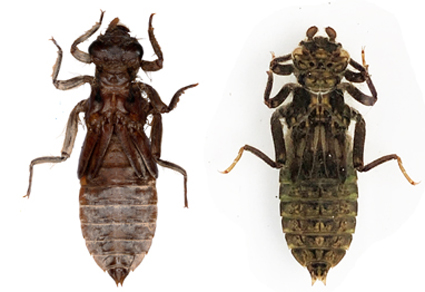Abstract
The last instar larvae of Davidius zallorensis Hagen in Selys, 1878 and Davidius davidii yunnanensis Yang & Davies, 1996 are described and illustrated for the first time from Erhai Lake Basin, Yunnan Province, China, based on the final stage larvae reared in laboratory; notes on their habitats are also provided. Differences among the larvae of this genus are discussed.
References
- Asahina, S. (1957) An annotated list of Japanese Odonata, with brief descriptions of their larvae, II. Gomphidae 3. Shin-Konchü, 10 (6), 51–58.
- Asahina, S. (1994) Records of the gomphid dragonflies recently collected by Japanese entomologists from Nepal and Darjeeling, 1. Tombo, 37 (1–4), 2–17.
- Asahina, S. (1996) Records of the Northern Vietnamese Odonata taken by the expedition members from the National Science Museum, Tokyo: 2. Gomphidae. Bulletin of the National Science Museum, Series A, Zoology, 22 (1), 21–32.
- Chao, H.F. (1995) New or little-known Gomphid dragonflies from China, I (Odonata: Gomphidae). Wuyi Science Journal, 12, 1–47.
- Corbet, P.S. (1953) A terminology for the Prementum of larval Odonata. The Entomologist, 86, 191–196.
- Fraser, F.C. (1923) Zoological results of the Percy Sladen Trust Expedition to Yunnan under the leadership of Professor JW Gregory, FRS (1922). Journal and Proceedings of the Asiatic Society of Bengal, New Series, 19, 447–464.
- Fraser, F.C. (1936) Odonata collected in Japen, with the descriptions of three new species. Transactions of the Royal Entomological Society of London, 85, 141–156. https://doi.org/10.1111/j.1365-2311.1936.tb00130.x
- Ishida, K. (1996) Monograph of Odonata larva in Japan. Hokkaido University Press, Sapporo, 546 pp.
- Kiyoshi, T. & Sota, T. (2006) Differentiation of the dragonfly genus Davidius (Odonata: Gomphidae) in Japan inferred from mitochondrial and nuclear gene genealogies. Zoological Science, 23 (1), 1–8. https://doi.org/10.2108/zsj.23.1
- Martin, R. (1904) Liste des Neuropteres deľ Indo-Chine. Mission Pavie Indo-Chine, 3, 204–221.
- Needham, J. (1930) A manual of the dragonflies of China. Zoologia Sinica, 11 (1), 1–344.
- Okumura, T. (1935) One new dragonfly from Hokkaido. Insecta Matsumurana, 10 (1–2), 64–66.
- Ozono, A., Kawashima, I. & Futahashi, R. (2019) The handbook of Japanese aquatic insects. Vol. 3. Dragonfly larvae. Bun-ichi Sogo Shuppan, Tokyo, 120 pp.
- Ozono, A., Kawashima, I. & Futahashi, R. (2020) Dragonflies of Japan. Bun-ichi Sogo Shuppan, Tokyo, 532 pp.
- Paulson, D., Schorr, M., Abbott, J., Bota-Sierra, C., Deliry, C., Dijkstra, K.-D. & Lozano, F. (Coordinators) (2024) World Odonata List. Odonata Central, University of Alabama, Tuscaloosa, Alabama. Available from: https://www.odonatacentral.org/app/#/wol/ (accessed 2 September 2024)
- Rasaily, B., Kalkman, V.J., Katel, O. & Dorji, C. (2021) Composition of the dragonfly fauna at different altitudes in Bhutan based on larval samples. International Dragonfly Fund: Report, 2021 (160), 1–20.
- Selys-Longchamps, E. (1869) Secondes addition au synopsis des Gomphines. Bulletin de l'Académie Royale de Belgique, 28 (2), 163–208.
- Selys-Longchamps, E. (1878) Quatriemes additions au synopsis des Gomphines. Bulletin de l'Académie Royale de Belgique, 2, 658–698.
- Watson, M.C. (1956) The utilization of mandibular armature in taxonomic studies of anisopterous nymphs. Transactions of the American Entomological Society, 81, 155–202.
- Yang, G.H., Mao, B.Y., Xu, J.S. & Yang, Z.Z. (2008) A preliminary report on the investigation of dragonflies from Cangshan nature reserve of Yunnan. Journal of Dali University, 7 (2), 9–11.
- Yang, B. & Davies, D.A.L. (1996) Two new species and one new subspecies of Gomphidae from southwestern China, with descriptions of larvae and distribution records (Anisoptera). Odonatologica, 25 (3), 283–296.
- Zhang, H.M. (2019) Dragonflies and Damselflies of China. Chongqing University Press, Chong Qing, 1462 pp.
- Zhao, X.F. (1990) The Gomphid Dragonflies of China (Odonata: Gomphidae). Fujian Science & Technology Publishing House, Fu Zhou, 486 pp.
- Zhu, H.Q., Yan, Z.D. & Li, S.S. (1988) Descriptions of three new taxa in the genus Davidius Selys from Shaanxi, China (Anisoptera: Gomphidae). Odonatologica, 17 (4), 429–434.


